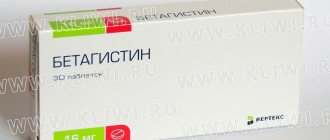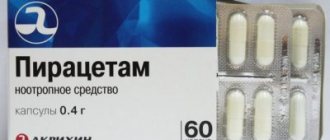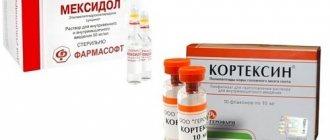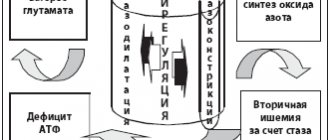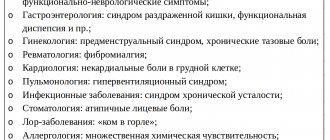Pharmacological properties of the drug Betaserc
Pharmacodynamics. The mechanism of action of betahistine is not fully understood. It increases blood circulation in the stria vascularis of the inner ear, by relaxing the precapillary sphincters in the microcirculation system of the inner ear. It has been established that betahistine has a weak agonistic effect on H1 receptors and a pronounced antagonistic effect on histamine H3 receptors in the central and autonomic nervous system. In addition, it was found that betahistine has a dose-dependent inhibitory effect on the generation of peak potentials in neurons of the lateral and medial vestibular nuclei. Betahistine accelerates the process of restoration of vestibular function after unilateral neurectomy, accelerating and facilitating the process of central vestibular compensation. This effect is characterized by increased regulation of histamine metabolism and release and is realized as a result of H3 receptor antagonism. In combination, all these properties provide a positive therapeutic effect of betahistine in the treatment of Meniere's disease and vestibular vertigo of various origins. Betahistine enhances the metabolism and release of histamine by blocking presynaptic H3 receptors, which leads to a decrease in their sensitivity. This effect on the histaminergic system explains the effectiveness of betahistine in the treatment of dizziness and vestibular disorders. Pharmacokinetics. After oral administration, betahistine is quickly and completely absorbed from the gastrointestinal tract. It is quickly and completely metabolized to form 2-pyridylacetic acid (a pharmacologically inactive metabolite). The concentration of betahistine in the blood plasma is low (below the detection limit ≤100pg/ml). In this regard, pharmacokinetic analyzes are carried out by measuring the metabolite 2-pyridylacetic acid in plasma and urine. The maximum concentration of the metabolite in the blood plasma is achieved 1 hour after administration. The half-life of 2-pyridylacetic acid is approximately 3.5 hours. 2-pyridylacetic acid is rapidly excreted from the body in the urine. When taking the drug in a dosage of 8-48 mg, about 85% of the initial dose is determined in the urine. Excretion of betahistine by the kidneys or feces is insignificant.
Betahistine – harmony of balance
About the article
10324
0
Regular issues of "RMZh" No. 20 dated 09/03/2009 p. 1366
Category: Neurology
Author: Ratbil O.E.
For quotation:
Ratbil O.E. Betahistine – harmony of balance. RMJ. 2009;20:1366.
The only beauty I know is health.
Heinrich Heine
Dizziness is one of the most common symptoms in medical practice. Among outpatients visiting doctors of all specialties, dizziness is the main complaint in 2–5% of cases. The cause of dizziness is an imbalance of sensory information coming from the main afferent systems that provide spatial orientation - vestibular, visual and proprioceptive. Dizziness is also one of the most common symptoms in patients with ischemic cerebral disease, especially with pathology of the vertebrobasilar system. In this group of patients, dizziness is usually caused by age-related changes in the sensory system, a decrease in the compensatory capabilities of the central mechanisms for maintaining balance, and cerebrovascular insufficiency with a predominant lesion of the vertebrobasilar system. In this case, changes in the vestibular nuclei of the trunk or vestibulo-cerebellar connections play a major role, but the so-called peripheral component, caused by atherosclerotic lesions of the vessels of the inner ear, also plays a certain role. In the clinic of neurological manifestations of cervical osteochondrosis, a special place is occupied by syndromes accompanied by severe dizziness. This is the so-called vertebrogenic vertebral artery syndrome, or posterior cervical sympathetic syndrome, which is caused by the impact of pathological bone and cartilage structures on the vertebral artery. Most often, the wall of the vessel is affected by uncovertebral growths, which deform the medial wall of the vessel or injure the surrounding sympathetic plexus, causing spasm of the artery and its branches. Manifestations of the syndrome unfold in the areas of vascularization of the branches of the vertebral artery. The clinical picture consists of headaches of occipital localization with frontal distribution, visual (in the form of subjective sensations of “fog”, “sand in the eyes”) and cochleovestibular disorders. The latter often come to the fore and are manifested by systemic and non-systemic dizziness, sometimes with nausea, vomiting, paraacusis (noise, hum, crackling) and hearing loss on the affected side. It should also be noted that there is a high incidence of dizziness (more than 20%) as a symptom in patients who have suffered uncomplicated concussions. The histaminergic system plays an important role in the functioning of the vestibular structures. Thus, the transmission of impulses from vestibular receptors and vestibular nuclei is provided primarily by histaminergic neurons. The main source of histaminergic innervation is the posterior hypothalamus, mainly the tuberomammillary nucleus, whose neurons are associated with almost all structures of the diencephalic region and telencephalon, including the basal ganglia and cortex, as well as with the brainstem and, in particular, with the vestibular nuclei complex. Histaminergic innervation is most represented in the medial vestibular nucleus. In peripheral vestibular disorders, there is an increase in spontaneous impulses of neurons of the ipsilateral vestibular nuclei, mainly the medial one. At the same time, there is a decrease in the expression of GABA receptors, which leads to the predominance of stimulating histaminergic influences. In addition, there is an increase in the density of GABA receptors in the contralateral medial vestibular nucleus. The histaminergic system also ensures the transmission of excitation between the vestibular nuclei and the vomiting center. Serotonergic, noradrenergic and dopaminergic innervation has a certain significance in the formation of connections of the vestibular system. One of the drugs that has a structural similarity to histamine and an affinity for blocking H3 receptors and stimulating H1 receptors is Tagista, containing betahistine hydrochloride. Due to the blockade of H3 receptors, Tagista increases the release of neurotransmitters from the nerve endings of the presynaptic membrane, has an inhibitory effect on the vestibular nuclei of the brain stem and improves blood supply to the inner ear. Betahistine was registered as a drug in Europe in 1970; it is a synthetic drug that has the ability to bind to H1 histamine receptors, which are located in the neuroreceptor cells of the inner ear. It has a local powerful stimulating effect, increasing the release of neurotransmitters (histamine) from the nerve endings of the receptor cells of the inner ear into the synapse. Neurotransmitters act on the precapillary sphincters, causing vasodilation of the vessels of the inner ear, increasing their permeability and thereby normalizing intralabyrinthine pressure, i.e. eliminating hydrops. In addition to affecting the receptors of the inner ear, betahistine has an effect on the receptors of the vestibular nuclei located in the medulla oblongata. Experimental work on animals has shown an increase in serotonin levels in the medulla oblongata. This leads to a decrease in the activity of the vestibular nuclei, a decrease in their excitability and the cessation of dizziness. Thus, a vestibulodepressive effect is manifested. The effectiveness of Tagista is associated with a decrease in both spontaneous and evoked impulses from vestibular receptors and vestibular nuclei. It was shown that the administration of betahistine led to a dose-dependent decrease in the frequency of spontaneous impulses from semicircular tubule receptors. In addition, Tagista helps to reduce the intensity and amplitude of impulses of neurons of the lateral vestibular nucleus both at rest and during stimulation. Tagista also stimulates the synthesis of endogenous histamine, as evidenced, in particular, by the increased synthesis of messenger RNA encoding histidine decarboxylase, the main enzyme in histamine synthesis. Along with the effect on histamine receptors in the peripheral and central vestibular structures, Tagista has a vasoactive effect. The drug causes dilation of the arterioles and capillaries of the inner ear, which leads to a selective increase in blood flow. In addition, taking the drug contributes to a slight increase in cerebral blood flow both in the vertebrobasilar and carotid areas, which leads to an improvement in cognitive functions in patients with chronic cerebrovascular insufficiency (Table 1). The administration of betahistine reduces the frequency, severity and duration of attacks of systemic dizziness (Table 2). Along with the positive effect on vestibular function, there is also an improvement in hearing during treatment, which is apparently due to the vasoactive effect of the drug. During a study of the effectiveness of betahistine [A.B. Gekht, 2001] in elderly patients with chronic vertebrobasilar insufficiency, significant positive dynamics of cochleovestibular disorders proper (dizziness, hearing loss, ataxia) were revealed. There was also a decrease in headaches and visual field defects. High tolerability of betahistine is very important when used in elderly patients with concomitant somatic pathology. Betahistine is also effective for relieving attacks of acute dizziness (vertigo). The drug reduces the frequency, duration and severity of attacks. Until recently, the medical trend has been to control very severe attacks of vertigo with labyrinthine drugs (prochlorperazine). Sedation, or drowsiness, is a common side effect of these drugs, which delay vestibular compensation [Kirtane, 1999]. Tagista at a dose of 16 mg 3 times a day. – best choice for controlling acute dizziness. In the clinic of acute vertigo, which occurs largely due to imbalances in electrical potentials in the vestibular nuclei of both hemispheres, the following tendency is revealed: during the acute phase, cerebellar cells inhibit the vestibular nuclei and thereby alleviate symptoms. This phenomenon is very figuratively called “cerebellar clamp”. Gradually, over several weeks, the vestibular nuclei of the undamaged side take over the function of the affected nuclei. This is observed anatomically as the emergence of cross-synapses and leads to a balance in the impulse activity of the nuclei of both sides. Once this happens, the vestibular nuclei are gradually released from the “cerebellar clamp” effect. This whole process is called “compensation”, thanks to which a person or animal who has suffered from acute attacks of vertigo regains a sense of balance, even if the original pathology is irreversible (Fig. 1-3). Most medications for dizziness cause sedation and CNS depression. This slows down the compensation process, which is so necessary for the patient's rehabilitation. Betahistine, which does not cause CNS depression, does not interfere with the compensation process. Tagista is not a sedative and therefore does not interfere with the patients’ normal lifestyle. The drug really has an “acceleration” effect on vestibular adaptation, which is vital for the speedy rehabilitation of patients with acute peripheral vestibular catastrophe. Biswas (1998), Tighilet et al. (1995) concluded from observations that taking betahistine per os (50 or 100 mg/per 1 kg of body weight) significantly accelerates recovery, restores statics and dynamics after transection of the left vestibular nerve in experimental cats and thus significantly accelerates vestibular compensation. Tagista is available in tablets of 8, 16 and 24 mg. The optimal daily dose is 48 mg. The most adequate therapeutic effect is achieved when taking the drug with food. The drug should be used with caution in patients suffering from peptic ulcer of the gastrointestinal tract (including a history of it), pheochromocytoma, and bronchial asthma. These patients should be monitored regularly during treatment. The duration of treatment in all cases is determined by the attending doctor, taking into account the clinical picture and individual characteristics of the patient.
Literature 1. Vereshchagin N.V. Pathology of the vertebrobasilar system and cerebrovascular accidents. M: Medicine, 1980. 312 p. 2. Vilensky V.S. Complications of stroke: prevention and treatment. St. Petersburg: Foliant, 2000. 128 p. 3. Gekht A.B., Gusev E.I., Bogolepova A.N., Alferova V.V. Principles of rehabilitation and pharmacotherapy of stroke patients in the recovery period // Materials of the VIII All-Russian Congress of Neurologists. Kazan, 2001. P. 220. 4. Gorbacheva F.E., Natyazhkina G.M., Chuchin M.Yu. Dizziness // Dizziness. – Consilium medicum. – 2001.– Appendix – pp. 63–66. 5. Gusev E.I., Gekht A.B., Bogolepova A.N., Dorzhieva N.N., Shimrigk G., Haas A. Results of a 3-year follow-up observation of patients with ischemic stroke (based on materials from the Stroke Data Bank ) // Neurological Journal, 2002. 6. Gusev E.I., Nikonov A.A., Skvortsova V.I. and others. Treatment of dizziness with Betaserc in patients with vascular and traumatic brain lesions // Journal. neurol. and a psychiatrist. 1998. No. 11. 7. Isaikin A.I., Yakhno N.N. Vertebral-basilar insufficiency // Breast cancer. 2002.Vol. 9, No. 25. 8. Lavrov A.Yu. Application of Betaserc in neurological practice // Neurological journal No. 2, 2002, vol. 6. 9. Abdulkerimov Kh.T., Markov I.S., Usachev V.I. Efficacy of Betaserc for vestibular disorders // Journal. neurol. and psychiatrist. 2002; 6: 50–52. 10. Boyko A.N., Derevyanko S.N., Luchikhin L.A., Slanova A.V., Gusev E.I. Betaserc in the symptomatic treatment of multiple sclerosis // Journal. neurol. and psychiatrist. 2002; 1:42–45. 11. Golubev V.L. Dizziness // Treatment of nervous diseases 2003; 2:3–9. 12. Kadymova M.I., Polyakova T.S. Application of Betaserc in patients with cochleovestibular disorders // Otorhinolary Bulletin. 1998; 3:7–9. 13. Lacour M. Histamine Vestibular function and vestibular compensation. Amsterdam: Elsvier 1998; 11–16. 14. Timmerman H. Pharmacotherapy of vertigo: any news to be expected? Acta otolaryngol 1994; Suppl 513:28–32. 15. Decher H. Horstorungen bel vertebrobasilar insuffizienz // Laryngol. Rhinol. Otol. – 1975. – Bd. 54, N9. – S. 728–734. 16. Oas JG, Baloh RW Vertigo and the anterior inferior cerebellar artery syndrome // Neurology. – 1992. – Vol. 42, N12. – P. 2274–2279. 17. Rivega V. M., Meyer JS, Baer PE at al. Vertebrobasilar arterial insufficiency with dementia: controlled trials of tritment with betahistine dihydrochloride. J Am Geriatr Soc 1974; 22: 397–406. 18. Babiyak V.I., Lantsov A.A., Bazarov V.G. Clinical vestibulology: A guide for doctors. – St. Petersburg: Hippocrates, 1996. – 336 p. 19. Oosterveld WJ Vertigo–Current concepts in managament 1985; 30: 275–283. 20. Braidu RA, Cute DG, Mhapanka JB, Narurka NK, Patil SF. Control symptoms of acute vertigo with betahistine. RMJ vol. 16, Pain syndrome, 2008, p. 45–51.
Use of the drug Betaserc
The daily dose for adults is 24–48 mg, evenly distributed throughout the day.
8 mg tablets | Tablets 16 mg | Tablets 24 mg |
| 1-2 tablets 3 times a day | 1 tablet 3 times a day | 1 tablet 2 times a day |
It is advisable to take the tablets after meals. The dose is selected individually depending on the effect. A decrease in symptoms is sometimes observed only after 2-3 weeks of treatment. The best results are achieved when taking the drug for several months. There is evidence that treatment early in the disease prevents progression and/or hearing loss in later stages.
Side effects of the drug Betaserc
The following adverse reactions were observed in patients who used Betaserc during placebo-controlled studies with the following frequencies: very common (≥ 1/10), common (≥1/100, ≤1/10), uncommon (≥1/1000, ≤ 1/100), single (≥1/10000, ≤1/1000), very rare (≤1/10000). From the side of the immune system Hypersensitivity reactions, incl. and immediate type (for example, cases of anaphylaxis have been reported). From the gastrointestinal tract Often: nausea and dyspepsia. In some cases, there were complaints of minor dyspeptic disorders (vomiting, pain along the gastrointestinal tract, abdominal pain due to bloating and flatulence). These side effects usually go away when you take the drug with food or after reducing the dose. From the skin and subcutaneous tissue In isolated cases, hypersensitivity reactions of the skin and subcutaneous tissue were observed, in particular angioedema, skin rash, itching and urticaria.
Special instructions for the use of Betaserc
During the use of the drug Betaserc, it is necessary to monitor the condition of patients with pheochromocytoma and asthma. It is also necessary to be careful when treating patients with a history of gastric and duodenal ulcers. Children. Due to insufficient data on the safety and effectiveness of the drug Betaserc, it is not recommended to prescribe the drug to children under the age of 18 years. Use during pregnancy or breastfeeding. Since toxicity studies on the reproductive system in animals do not always allow one to assess the possibility of a toxic effect in humans, during pregnancy the drug should be taken only if there is an undeniable need and under the direct supervision of a physician. The penetration of betahistine into breast milk has not been studied. The benefits of taking the drug should be compared with the benefits of breastfeeding and the potential risk to the child. The ability to influence the reaction speed when driving vehicles and working with other mechanisms. No studies have been conducted.
Betaserk, Betaver, Vestibo or Tagista - which is better?
What's better? The question does not have a clear answer. After all, any medicine has many parameters. For some, effectiveness in relation to the symptoms of interest is important (for the drugs we are currently considering, this is, first of all, dizziness and tinnitus). For some, the safety of the drug is more important. For some people, price comes to the fore. And some even look at the availability of the product in the pharmacy near their home.
So which is better? In terms of effectiveness, in my humble opinion, the original drug, Betaserc (Abbot), comes to the fore. However, Vestibo (Actavis) is not much worse than the original and is produced by a self-respecting company. Their safety profile does not differ much (however, all betahistine preparations are quite safe and have virtually no side effects). The drugs Betaver (Veropharm) and Tagista (Shtada) differ significantly in effectiveness, but they also greatly benefit in price. Moreover, according to this indicator, Betaserc is the “worst”. Although, if you compare the effectiveness, time to achieve improvement and the price of the entire course of treatment, this bright line in price is erased in favor of Betaserc.
To summarize the above, I would like to say the following. The original betahistine drug is Betaserc. Not much inferior in efficiency to Vestibo. In terms of price, the cheapest of the above tablets is Tagista. The choice of a specific medicine will be yours, dear site visitors. Be healthy!
